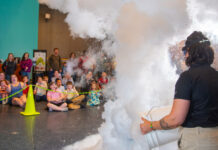
Betamovie released the first commercially available camcorder in 1983, and parties from b’nai mitzvahs to quinceañeras to Sweet 16s have never been the same. Documenting the major moments in life became accessible and more affordable. It wasn’t uncommon to see a professional videographer and a cousin or two taping everything from the ceremony to the party to the cleanup.
The then-new technology changed the face of coming-of-age parties from that point forward, but what about now? Social media has become the new catalyst for change in how we celebrate our big moments.
In June of 2007, Apple rolled out the first iPhone. Instagram came onto the scene in late 2010, and suddenly everyone and their mother could capture and share these lifetime memories. With TikTok in 2016, social media had officially exploded into our lives.
“We actually just got a request for a TikTok -themed party,” says Heidi Hiller of Innovative Party Planners, an Owings Mills -based agency with clientele throughout Maryland, Washington, D.C., Virginia and Pennsylvania.
Since Hiller launched her business in 1996, “a lot has changed,” she says with a laugh. As her company’s chief event officer, Hiller has seen it all, and she’s seen things change again and again.
The advent of social media and other global and cultural changes have affected our lives, including how we party. Hiller shares the trends in party planning that continue to shape our iconic celebrations and offers her advice for parents at the planning stages.
Social (Media) Etiquette

With children now getting smartphones at a younger age, parents must figure out when and where social media fits into their lives.
“Kids are getting into social media at a younger age. These teenagers are begging their parents for accounts around the time they start to get ready for their bar mitzvahs,” Hiller says. When planning these milestone parties, parents and kids need to come to an agreement about what works best for them. These questions range from who can take pictures at the party to when to post them and whether or not to use a specific hashtag for the event.
“We want everyone to be present at the party,” Hiller says. “We don’t want their phones out the whole time. We want kids to actually enjoy it in the moment. The devices don’t need to be part of the party.”
Hiller does, however, understand that phones can provide a source of comfort to young partygoers. Texting someone who isn’t at the event and taking and posting pictures after it is over can be fine if done with some moderation.
She suggests parents sit down with their children at the beginning of the planning to find out what works for everyone—when to have phones out at the party and what to post and when. “Set some good ground rules,” she says. Hiller does strongly recommend not posting about the party until it is over for both safety concerns and to “stay in the moment” at the event.
A Step Toward Inclusivity

It’s not just phones and social media that have changed in recent years. Even the language that planners and families use throughout the planning process is changing. With the increasing visibility of trans and non-binary children, there has been a shift in how to address people, and not just for the guest of honor. “It all starts with the invitations,” Hiller says. “How do we want to address the envelopes and place cards and speeches? Do we want to say, ‘ladies and gentlemen’ or do we want to say something else?”
With non-binary children, what should you even call a bar or bat mitzvah? “A b’mitzvah,” Hiller says. “Or a b’rit mitzvah or a simchat bat.” When working with clients who have gender-fluid, non-binary or transgender family members, Hiller is careful to let the vendors know how to handle conversations so that no one feels uncomfortable. She sees it as an important part of her job to make everyone involved in the planning and the big day feel welcome.
Size and Cost
The coronavirus pandemic also changed how people have their parties now. People seem to have gone one of two ways with their planning, Hiller says—going either bigger or smaller.
“Some kids have just gotten used to being in smaller crowds and aren’t as comfortable being in large crowds anymore,” Hiller says. “And some families are doing bigger parties because people did spend so much time without each other and they want to celebrate in a big way now.” Finding what works for each family is a big part of the early stages of planning these fantastic fêtes.
Cost also plays a large role in the size of many parties. “You shouldn’t make your party more than you can afford,” Hiller says. “But even saying that, having an event is a luxury, and I don’t think having an event for 150 people is affordable for many people anymore.”

Many party planners use social media to market their companies and their products, Hiller says, which makes people think that they need to spend lavishly on these parties. “What you see online from these planners is not what most people are doing.”
Hiller urges parents to set a budget and really think about how they want to spend their money. “The age these kids are, it’s a really important time to figure out what the important values are for them. This is such a learning and teaching opportunity.”
She sees these parties as an investment. “It’s going to cost as much as a car,” Hiller says. “And if you’re going to spend that much money on an event like this, you really want to think about getting a planner. Find a professional who can find ways to make your money go where it matters to you.”
What Matters Most
Even more important than decisions about elements such as budget or social media use at a party is making sure the party is about what the teen wants. Hiller likes to meet with the child in addition to the parents at the outset of the planning. “We have to respect and honor the [parents’] wishes, but we really do try to steer them toward what the kid wants,” she says.
“We often ask for a meeting with the child, but we have to be careful that all voices are heard,” Hiller adds. “Sometimes, we don’t meet with the kid, and that can be OK, too. It’s so important to ask questions like, ‘Is your kid comfortable in a crowd?’ etc. We do want to make sure everyone has a good time.” She recommends finding out what interests your child has and what they want out of the party to help things go more smoothly.
Above and beyond everything, Hiller wants people to remember that at a coming-of-age party, be it a quinceañera, a Sweet 16 or a b’nai mitzvah, everyone will have a different experience. “Parents, grandparents and kids all go through this in a different way, and with attention to detail, we can make everyone happy.”








